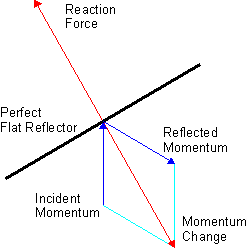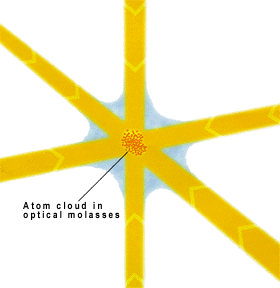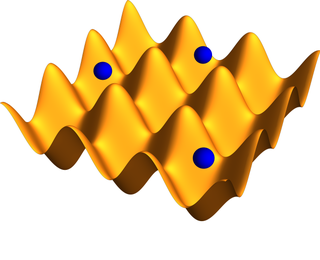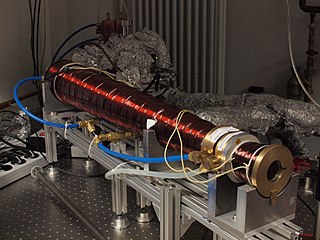
In condensed matter physics, a Bose–Einstein condensate (BEC) is a state of matter that is typically formed when a gas of bosons at very low densities is cooled to temperatures very close to absolute zero, i.e., 0 K. Under such conditions, a large fraction of bosons occupy the lowest quantum state, at which microscopic quantum-mechanical phenomena, particularly wavefunction interference, become apparent macroscopically. More generally, condensation refers to the appearance of macroscopic occupation of one or several states: for example, in BCS theory, a superconductor is a condensate of Cooper pairs. As such, condensation can be associated with phase transition, and the macroscopic occupation of the state is the order parameter.

Radiation pressure is mechanical pressure exerted upon a surface due to the exchange of momentum between the object and the electromagnetic field. This includes the momentum of light or electromagnetic radiation of any wavelength that is absorbed, reflected, or otherwise emitted by matter on any scale. The associated force is called the radiation pressure force, or sometimes just the force of light.

Laser cooling includes several techniques where atoms, molecules, and small mechanical systems are cooled with laser light. The directed energy of lasers is often associated with heating materials, e.g. laser cutting, so it can be counterintuitive that laser cooling often results in sample temperatures approaching absolute zero. It is a routine step in many atomic physics experiments where the laser-cooled atoms are then subsequently manipulated and measured, or in technologies, such as atom-based quantum computing architectures. Laser cooling relies on the change in momentum when an object, such as an atom, absorbs and re-emits a photon. For example, if laser light illuminates a warm cloud of atoms from all directions and the laser's frequency is tuned below an atomic resonance, the atoms will be cooled. This common type of laser cooling relies on the Doppler effect where individual atoms will preferentially absorb laser light from the direction opposite to the atom's motion. The absorbed light is re-emitted by the atom in a random direction. After repeated emission and absorption of light the net effect on the cloud of atoms is that they will expand more slowly. The slower expansion reflects a decrease in the velocity distribution of the atoms, which corresponds to a lower temperature and therefore the atoms have been cooled. For an ensemble of particles, their thermodynamic temperature is proportional to the variance in their velocity, therefore the lower the distribution of velocities, the lower temperature of the particles.
Resolved sideband cooling is a laser cooling technique allowing cooling of tightly bound atoms and ions beyond the Doppler cooling limit, potentially to their motional ground state. Aside from the curiosity of having a particle at zero point energy, such preparation of a particle in a definite state with high probability (initialization) is an essential part of state manipulation experiments in quantum optics and quantum computing.

Optical molasses is a laser cooling technique that can cool neutral atoms to as low as a few microkelvin, depending on the atomic species. An optical molasses consists of 3 pairs of counter-propagating orthogonally polarized laser beams intersecting in the region where the atoms are present. The main difference between an optical molasses (OM) and a magneto-optical trap (MOT) is the absence of magnetic field in the former. Unlike a MOT, an OM provides only cooling and no trapping.

An optical lattice is formed by the interference of counter-propagating laser beams, creating a spatially periodic polarization pattern. The resulting periodic potential may trap neutral atoms via the Stark shift. Atoms are cooled and congregate at the potential extrema. The resulting arrangement of trapped atoms resembles a crystal lattice and can be used for quantum simulation.

Doppler cooling is a mechanism that can be used to trap and slow the motion of atoms to cool a substance. The term is sometimes used synonymously with laser cooling, though laser cooling includes other techniques.

In atomic, molecular, and optical physics, a magneto-optical trap (MOT) is an apparatus which uses laser cooling and a spatially-varying magnetic field to create a trap which can produce samples of cold, neutral atoms. Temperatures achieved in a MOT can be as low as several microkelvin, depending on the atomic species, which is two or three times below the photon recoil limit. However, for atoms with an unresolved hyperfine structure, such as 7Li, the temperature achieved in a MOT will be higher than the Doppler cooling limit.
In condensed matter physics, an ultracold atom is an atom with a temperature near absolute zero. At such temperatures, an atom's quantum-mechanical properties become important.
In spectroscopy, the Autler–Townes effect, is a dynamical Stark effect corresponding to the case when an oscillating electric field is tuned in resonance to the transition frequency of a given spectral line, and resulting in a change of the shape of the absorption/emission spectra of that spectral line. The AC Stark effect was discovered in 1955 by American physicists Stanley Autler and Charles Townes.
The Gross–Pitaevskii equation describes the ground state of a quantum system of identical bosons using the Hartree–Fock approximation and the pseudopotential interaction model.
The manipulation of atoms using optical fields is a vital and fundamental area of research within the field of atomic physics. This research revolves around leveraging the distinct characteristics of laser light and coherent optical fields to achieve precise control over various aspects of atomic systems. These aspects encompass regulating atomic motion, positioning atoms, manipulating internal states, and facilitating intricate interactions with neighboring atoms and photons. The utilization of optical fields provides a powerful toolset for exploring and understanding the quantum behavior of atoms and opens up promising avenues for applications in atomic, molecular, and optical physics.
The Kapitza–Dirac effect is a quantum mechanical effect consisting of the diffraction of matter by a standing wave of light, in complete analogy to the diffraction of light by a periodic grating, but with the role of matter and light reversed. The effect was first predicted as the diffraction of electrons from a standing wave of light by Paul Dirac and Pyotr Kapitsa in 1933. The effect relies on the wave–particle duality of matter as stated by the de Broglie hypothesis in 1924. The matter-wave diffraction by a standing wave of light was first observed using a beam of neutral atoms. Later, the Kapitza-Dirac effect as originally proposed was observed in 2001.

In ultra-low-temperature physics, Sisyphus cooling, the Sisyphus effect, or polarization gradient cooling involves the use of specially selected laser light, hitting atoms from various angles to both cool and trap them in a potential well, effectively rolling the atom down a hill of potential energy until it has lost its kinetic energy. It is a type of laser cooling of atoms used to reach temperatures below the Doppler cooling limit. This cooling method was first proposed by Claude Cohen-Tannoudji in 1989, motivated by earlier experiments which observed sodium atoms cooled below the Doppler limit in an optical molasses. Cohen-Tannoudji received part of the Nobel Prize in Physics in 1997 for his work. The technique is named after Sisyphus, a figure in the Greek mythology who was doomed, for all eternity, to roll a stone up a mountain only to have it roll down again whenever he got it near the summit.

In atomic physics, a Zeeman slower is a scientific instrument that is commonly used in atomic physics to slow and cool a beam of hot atoms to speeds of several meters per second and temperatures below a kelvin. The gas-phase atoms used in atomic physics are often generated in an oven by heating a solid or liquid atomic sample to temperatures where the vapor pressure is high enough that a substantial number of atoms are in the gas phase. These atoms effuse out of a hole in the oven with average speeds on the order of hundreds of m/s and large velocity distributions. The Zeeman slower is attached close to where the hot atoms exit the oven and are used to slow them to less than 10 m/s (slowing) with a very small velocity spread (cooling).
In atomic physics, Raman cooling is a sub-recoil cooling technique that allows the cooling of atoms using optical methods below the limitations of Doppler cooling, Doppler cooling being limited by the recoil energy of a photon given to an atom. This scheme can be performed in simple optical molasses or in molasses where an optical lattice has been superimposed, which are called respectively free space Raman cooling and Raman sideband cooling. Both techniques make use of Raman scattering of laser light by the atoms.
In ion trapping and atomic physics experiments, the Lamb Dicke regime is a quantum regime in which the coupling between an ion or atom's internal qubit states and its motional states is sufficiently small so that transitions that change the motional quantum number by more than one are strongly suppressed.
Sub-Doppler cooling is a class of laser cooling techniques that reduce the temperature of atoms and molecules below the Doppler cooling limit. In experiment implementation, Doppler cooling is limited by the broad natural linewidth of the lasers used in cooling. Regardless of the transition used, however, Doppler cooling processes have an intrinsic cooling limit that is characterized by the momentum recoil from the emission of a photon from the particle. This is called the recoil temperature and is usually far below the linewidth-based limit mentioned above.
Gray molasses is a method of sub-Doppler laser cooling of atoms. It employs principles from Sisyphus cooling in conjunction with a so-called "dark" state whose transition to the excited state is not addressed by the resonant lasers. Ultracold atomic physics experiments on atomic species with poorly-resolved hyperfine structure, like isotopes of lithium and potassium, often utilize gray molasses instead of Sisyphus cooling as a secondary cooling stage after the ubiquitous magneto-optical trap (MOT) to achieve temperatures below the Doppler limit. Unlike a MOT, which combines a molasses force with a confining force, a gray molasses can only slow but not trap atoms; hence, its efficacy as a cooling mechanism lasts only milliseconds before further cooling and trapping stages must be employed.
Polarization gradient cooling is a technique in laser cooling of atoms. It was proposed to explain the experimental observation of cooling below the doppler limit. Shortly after the theory was introduced experiments were performed that verified the theoretical predictions. While Doppler cooling allows atoms to be cooled to hundreds of microkelvin, PG cooling allows atoms to be cooled to a few microkelvin or less.











